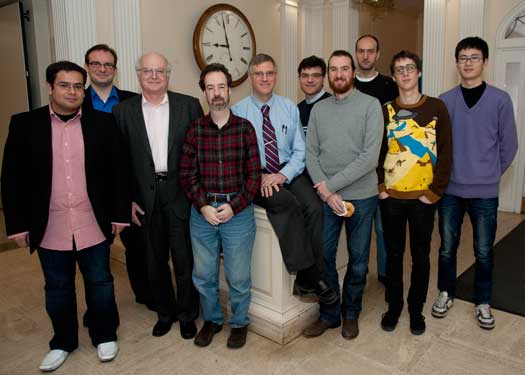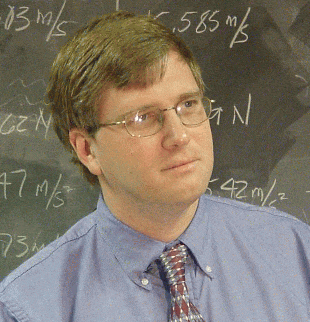Subatomic particle can explain why matter has mass
In a giant game of hide and seek, physicists say there are indications they finally may have found evidence of the long sought after fundamental particle called the Higgs boson.
Researchers at Switzerland-based CERN, the largest high-energy physics experiment in the world, have been seeking the Higgs boson since it was theorized in the 1960s.
The so-called “God” particle is believed to play a fundamental role in solving the important mystery of why matter has mass.
Thousands of scientists from around the world seek evidence of the Higgs particle through experiments at CERN’s Large Hadron Collider. The researchers analyze a flood of electronic data streaming from the breakup of speeding protons colliding in the massive particle accelerator. Scientists on Tuesday announced in a seminar held at CERN that they’ve found hints of the Higgs.

Physicist and SMU Professor Ryszard Stroynowski answers questions from SMU students, faculty and the public who viewed a web cast of CERN's press conference in Geneva on Tuesday. (Credit: Hillsman Jackson)
“Now we have a strong indication, but not yet a confirmation, of a discovery,” said Southern Methodist University physicist Ryszard Stroynowski, the leader of SMU’s team of scientists working on the experiment.
Higgs: Attempting to discover Standard Model’s missing piece
Theorists have predicted that some subatomic particles gain mass by interacting with other particles called Higgs bosons. The Higgs boson is the only undiscovered part of the Standard Model of physics, which describes the basic building blocks of matter and their interactions.
Higgs bosons, if they exist, are short-lived and can decay in many different ways. Just as a vending machine might return the same amount of change using different combinations of coins, the Higgs can decay into different combinations of particles. Discovery relies on observing statistically significant excesses of the particles into which they decay rather than observing the Higgs itself.
“If indeed we are able to confirm sighting of the Higgs in the months ahead, this clearly focuses our future studies,” said Stroynowski, a professor in the SMU Department of Physics. “Now by the middle of next year we’ll know for sure if this particle exists and we can begin to study its properties. This is a very big step in the understanding of particle physics.”

An event showing four muons (red tracks) from a proton-proton collision in ATLAS. This event is consistent with two Z particles decaying into two muons each. Such events are produced by Standard Model processes without Higgs particles. They are also a possible signature for Higgs particle production, but many events must be analyzed together in order to tell if there is a Higgs signal. (Credit: CERN)
SMU researchers contributed to the results announced Tuesday by CERN
Besides Stroynowski, the SMU team of researchers includes three other Physics Department faculty: Jingbo Ye, Robert Kehoe and Stephen Sekula, six postdoctoral fellows and five graduate students. Main contributions to the new analysis of the data were made by postdoctoral researcher Julia Hoffman and graduate student Ryan Rios.
Others in the department who have contributed include former postdoctoral fellow David Joffe, now an assistant professor at Kennesaw State University, graduate students Renat Ishmukhametov and Rozmin Daya and theoretical faculty Fredrick Olness and Pavel Nadolsky.
Stroynowski, Hoffman, and Rios are among the more than 70 scientists whose work directly contributed to the conference papers reporting the findings, said Olness, a professor and chairman of the SMU Department of Physics.
While thousands of scientists worldwide participated directly and indirectly in the experiments, SMU is one of only a few U.S. universities whose scientists are named among the 70 researchers directly cited on one of the three conference papers.
“Professor Stroynowski has demonstrated extraordinary scientific leadership in keeping our relatively small Department of Physics at SMU engaged in one of the most significant scientific experiments of our time,” said Jim Quick, SMU Associate Vice President for Research.
SMU’s role in the LHC experiments provides SMU students a chance to participate in pioneering discoveries, said Olness.
“SMU students helped build the ATLAS detector, they were in the control room when the experiment started up, and they contributed to the analysis,” he said. “The results presented today are historic, and they will help shape our view of the matter and forces that comprise our universe; SMU students have played a role in this achievement.”
Higgs discovery would confirm decades-old theory

In Fondren Science Building, physicist and SMU Physics Professor Ryszard Stroynowski and physics graduate student Ryan Rios discuss the Higgs boson after viewing a CERN web cast Tuesday announcing evidence of the Higgs. (Credit: Hillsman Jackson)
Discovering the type of Higgs boson predicted in the Standard Model would confirm a theory first put forward in the 1960s.
“This year, the LHC has come roaring into the front of the hunt for the Higgs boson and may be poised to either identify it, or refute its existence, in the coming months,” said Robert Kehoe, associate professor in the SMU Department of Physics. “As I like to tell my students learning modern physics, ‘You still live in a world in which we do not know for sure the mechanism breaking the symmetry between electromagnetic and weak interactions. That world may be soon to change forever. We may soon see a truly new thing.’”
Even if the LHC experiments find a particle where they expect to find the Higgs, it will take more analysis and more data to prove it is a Standard Model Higgs, according to CERN researchers. If scientists found subtle departures from the Standard Model in the particle’s behavior, this would point to the presence of new physics, linked to theories that go beyond the Standard Model. Observing a non-Standard Model Higgs, currently beyond the reach of the LHC experiments with the data they’ve recorded so far, would immediately open the door to new physics, said an official statement from CERN.
Results constrain Higgs’ mass to a range more limited than before

SMU faculty Fredrick Olness, Thomas Coan and Robert Kehoe in Fondren Science Building on Tuesday listen to a web cast from Switzerland's CERN announcing hints of the Higgs boson. (Credit: Hillsman Jackson)
In announcing the findings, CERN noted that two experiments at the LHC have nearly eliminated the space in which the Higgs boson could dwell. The ATLAS and CMS experiments see modest excesses in their data that could soon uncover the famous missing piece of the physics puzzle, the scientists said.
The experiments’ main conclusion is that the Standard Model Higgs boson, if it exists, is most likely to have a mass constrained to the range 116-130 giga-electron-volts (GeV) by the ATLAS experiment, and 115-127 GeV by CMS. Tantalizing hints have been seen by both experiments in this mass region, but these are not yet strong enough to claim a discovery.
Both ATLAS and CMS have analyzed several decay channels, and the experiments see small excesses in the low mass region that has not yet been excluded.
Taken individually, none of these excesses is any more statistically significant than rolling a die and coming up with two sixes in a row. What is interesting is that there are multiple independent measurements pointing to the region of 124 to 126 GeV. It’s far too early to say whether ATLAS and CMS have discovered the Higgs boson, but these updated results are generating a lot of interest in the particle physics community.
The experiments revealed the latest results as part of their regular report to the CERN Council, which provides oversight for the laboratory near Geneva, Switzerland.
Experiments in coming months will refine the analysis
More than 1,600 scientists, students, engineers and technicians from more than 90 U.S. universities and five U.S. national laboratories take part in the ATLAS and CMS experiments. The Department of Energy’s Office of Science and the National Science Foundation provide support for U.S. participation in these experiments.
Over the coming months, both the ATLAS and CMS experiments will focus on refining their analyses in time for the winter particle physics conferences in March. The experiments will resume taking data in spring 2012.
Another possibility, discovering the absence of a Standard Model Higgs, would point to new physics at the LHC’s full design energy, set to be achieved after 2014. Whether ATLAS and CMS show over the coming months that the Standard Model Higgs boson exists or not, the LHC program is closing in on new discoveries. — CERN, Southern Methodist University
SMU is a member of the ATLAS experiment at the LHC. It takes a large team of scientists to search for the Higgs and other new physics; the SMU delegation includes faculty members Ryszard Stroynowski, Jingbo Ye, Robert Kehoe, Stephen Sekula, and a number of research professors, postdoctoral fellows and graduate students.
In addition, recent SMU ATLAS contributors include postdoctoral fellows Julia Hoffman, David Joffe (now at Kennesaw State), Ana Firan, Haleh Hadavand, Sami Kama, Aidan Randle-Conde and Peter Renkel, and graduate students Ryan Rios, Rozmin Daya, Renat Ishmukhametov Tingting Cao and Kamile Dindar-Yagci. Theoretical support was provided by faculty member Pavel Nadolsky, electronics development by research professors Andy Liu and Annie Xiang, and computer support by Justin Ross.

SMU Physics Department faculty and students gathered early Tuesday in Fondren Science Building to hear CERN's web cast announcing results showing hints of the Higgs boson. (Credit: Hillsman Jackson)
SMU is a nationally ranked private university in Dallas founded 100 years ago. Today, SMU enrolls nearly 11,000 students who benefit from the academic opportunities and international reach of seven degree-granting schools. For more information see www.smuresearch.com.
SMU has an uplink facility on campus for live TV, radio or online interviews. To speak with an SMU expert or to book them in the SMU studio, call SMU News & Communications at 214-768-7650 or UT Dallas Office of Media Relations at 972-883-4321.

